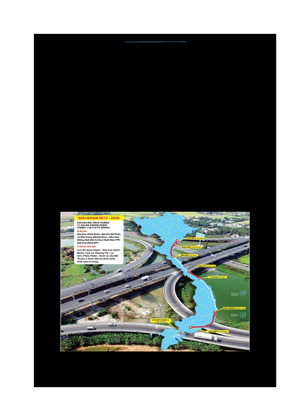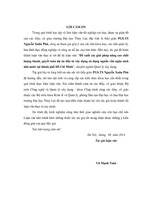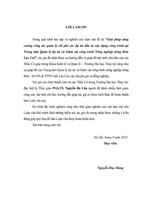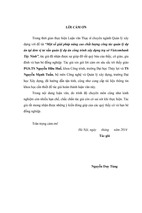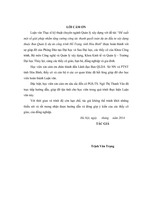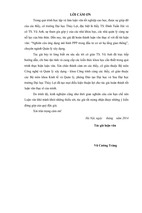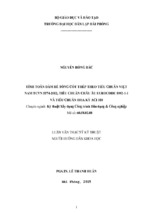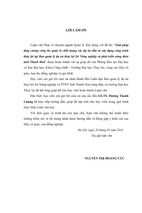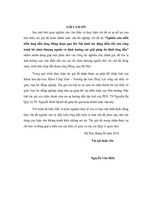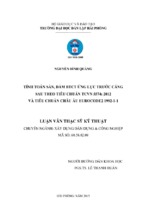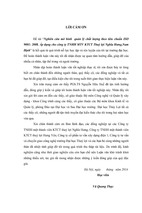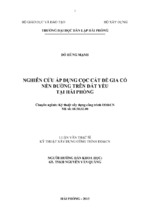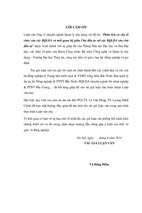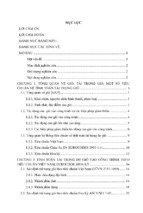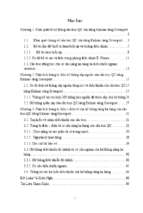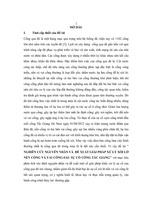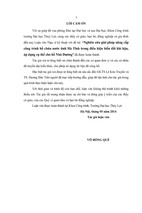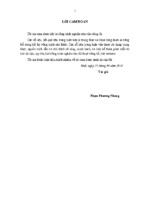BỘ GIÁO DỤC VÀ ĐÀO TẠO
TRƯỜNG ĐẠI HỌC QUẢN LÝ VÀ CÔNG NGHỆ HẢI PHÒNG
-------------------------------
ISO 9001:2015
KHÓA LUẬN TỐT NGHIỆP
NGÀNH: NGÔN NGỮ ANH
Sinh viên
: NGÔ THỊ HIỀN
Giảng viên hướng dẫn: Th.S BÙI THỊ MAI ANH
HẢI PHÒNG 07– 2020
i
BỘ GIÁO DỤC VÀ ĐÀO TẠO
TRƯỜNG ĐẠI HỌC QUẢN LÝ VÀ CÔNG NGHỆ HẢI PHÒNG
-----------------------------------
HOW TO INCREASE STUDENTS’ PARTICIPATION IN
COMMUNICATIVE ACTIVITIES IN LARGE CLASSES BY
USING GROUP WORK AND QUESTIONING TECHNIQUE
IN HAI AN HIGH SCHOOL, HAI PHONG
KHÓA LUẬN TỐT NGHIỆP ĐẠI HỌC HỆ CHÍNH QUY
NGÀNH: NGÔN NGỮ ANH
Sinh viên
: NGÔ THỊ HIỀN
Giảng viên hướng dẫn: Th.S BÙI THỊ MAI ANH
HẢI PHÒNG 07 – 2020
ii
BỘ GIÁO DỤC VÀ ĐÀO TẠO
TRƯỜNG ĐẠI HỌC QUẢN LÝ VÀ CÔNG NGHỆ HẢI PHÒNG
--------------------------------------
NHIỆM VỤ ĐỀ TÀI TỐT NGHIỆP
Sinh viên: NGÔ THỊ HIỀN
Lớp
: NA1701
Ngành
: NGÔN NGỮ ANH
Mã SV: 1312401166
Tên đề tài: How to increase students’ participation in communicative
activities in large classes by using group work and questioning technique in Hai
An High School, Hai Phong
iii
NHIỆM VỤ ĐỀ TÀI
1.
Nội dung và các yêu cầu cần giải quyết trong nhiệm vụ đề tài tốt
nghiệp
…………………………………………………………………………………
…………………………………………………………………………………
…………………………………………………………………………………
…………………………………………………………………………………
…………………………………………………………………………………
…………………………………………………………………………………
2.
Các tài liệu, số liệu cần thiết
…………………………………………………………………………………
…………………………………………………………………………………
…………………………………………………………………………………
…………………………………………………………………………………
…………………………………………………………………………………
3.
Địa điểm thực tập tốt nghiệp
CÔNG TY TNHH Thực phẩm T&Q Hải Phòng
iv
CÁN BỘ HƯỚNG DẪN ĐỀ TÀI TỐT NGHIỆP
Họ và tên
: Bùi Thị Mai Anh
Học hàm, học vị
: Thạc sỹ
Cơ quan công tác
: Trường Đại học Quản lý và Công nghệ Hải Phòng
Nội dung hướng dẫn: How to increase students’ participation in
communicative activities in large classes by using group work and
questioning technique in Hai An High School, Hai Phong
Đề tài tốt nghiệp được giao ngày 30 tháng 03 năm 2020
Yêu cầu phải hoàn thành xong trước ngày 30 tháng 06 năm 2020
Đã nhận nhiệm vụ ĐTTN
Đã giao nhiệm vụ ĐTTN
Sinh viên
Giảng viên hướng dẫn
Hải Phòng, ngày 01 tháng 07 năm 2020
HIỆU TRƯỞNG
v
CỘNG HÒA XÃ HỘI CHỦ NGHĨA VIỆT NAM
Độc lập – Tự do – Hạnh phúc
PHIẾU NHẬN XÉT CỦA GIẢNG VIÊN HƯỚNG DẪN TỐT NGHIỆP
Họ và tên giảng viên:
BÙI THỊ MAI ANH
Đơn vị công tác:
Khoa Ngoại ngữ
Đại học Quản lý và Công nghệ Hải Phòng
Họ và tên sinh viên:
NGÔ THỊ HIỀN
Chuyên ngành: Ngôn ngữ Anh
Đề tài tốt nghiệp:
How to increase students’ participation in communicative
activities in large classes by using group work and
questioning technique in Hai An High School, Hai Phong
Nội dung hướng dẫn:
Tăng cường sự tham gia của học sinh vào các hoạt động
trong lớp có sĩ số lớn bằng việc sử dụng phương pháp làm
việc nhóm và đặt câu hỏi tại trường THPT Hải An, Hải
Phòng
1. Tinh thần thái độ của sinh viên trong quá trình làm đề tài tốt nghiệp
.......................................................................................................................................................
.......................................................................................................................................................
.......................................................................................................................................................
.......................................................................................................................................................
.......................................................................................................................................................
2. Đánh giá chất lượng của đồ án/khóa luận (so với nội dung yêu cầu đã đề ra trong
nhiệm vụ Đ.T. T.N trên các mặt lý luận, thực tiễn, tính toán số liệu…)
.......................................................................................................................................................
.......................................................................................................................................................
.......................................................................................................................................................
.......................................................................................................................................................
3. Ý kiến của giảng viên hướng dẫn tốt nghiệp
Được bảo vệ
Không được bảo vệ
Điểm hướng dẫn
Hải Phòng, ngày …… tháng …… năm ……
Giảng viên hướng dẫn
(Ký và ghi rõ họ tên)
vi
CỘNG HÒA XÃ HỘI CHỦ NGHĨA VIỆT NAM
Độc lập – Tự do – Hạnh phúc
QC20-B18
PHIẾU NHẬN XÉT CỦA GIẢNG VIÊN CHẤM PHẢN BIỆN
Họ và tên giảng viên:
Đơn vị công tác:
Khoa Ngoại ngữ
Đại học Quản lý và Công nghệ Hải Phòng
Họ và tên sinh viên:
NGÔ THỊ HIỀN
Chuyên ngành: Ngôn ngữ Anh
Đề tài tốt nghiệp:
How to increase students’ participation in communicative
activities in large classes by using group work and
questioning technique in Hai An High School, Hai Phong
1. Phần nhận xét của giáo viên chấm phản biện
...... ..........................................................................................................................................
...... ..........................................................................................................................................
...... ..........................................................................................................................................
...... ..........................................................................................................................................
...... ..........................................................................................................................................
...... ..........................................................................................................................................
...... ..........................................................................................................................................
2. Những mặt còn hạn chế
..........................................................................................................................................
...... ..........................................................................................................................................
...... ..........................................................................................................................................
...... ..........................................................................................................................................
...... ..........................................................................................................................................
...... ..........................................................................................................................................
...... ..........................................................................................................................................
3. Ý kiến của giảng viên chấm phản biện
Được bảo vệ
Không được bảo vệ
Điểm phản biện
Hải Phòng, ngày … tháng … năm ......
Giảng viênchấm phản biện
(Ký và ghi rõ họ tên)
QC20-B19
vii
ACKNOWLEDGEMENT
During the process of doing the graduation paper, I have received a lot of help,
assistance, guidance and encouragement from my teachers, family and friends.
First and foremost, I would like to express my deepest gratitude to my
supervisor Ms. Bui Thi Mai Anh, M.A, the lecturer of foreign language faculty,
Haiphong Management and Technology University, for her whole-hearted guidance
and support. Without her invaluable recommendations and advice, I could not finish
this thesis.
My sincere thanks are also sent to all the teachers of English Department at
Haiphong Management and Technology University for their precious and useful
lessons during my four year study which have been then the foundation of this
research paper and all the students of NA1701, NA1801 and NA1802 who
enthusiastically help me complete the survey questionnaires.
Last but not least, I would like to give my heartfelt thanks to my family, my
friends who always encourage and inspire me to complete this graduation paper.
Hai Phong, June 2020
Ngo Thi Hien
viii
TALBLE OF CONTENS
Acknowledgement…………….……………………………………………………i
Table of contents …………………………………………………………………..ii
List of abbreviations ……………………………………………...……………….iv
PART A: INTRODUCTION
1. Rationale………………………………………………………………….. 1
2. Aims of the study………………………………………………………… 2
3. Research questions………………………………………………………. 2
4. Scope of the study………………………………………………………… 3
5. Methods of the study………………………………………………………..3
6. Design of the study………………………………………………………….4
PART B: DEVELOPMENT
CHAPTER I: LITERATURE REVIEW
1. Communicative Language Teaching
1.1. What is Communicative Language Teaching (CLT)……..5
1.2. Activities in Communicative Language Teaching………..8
2. Teaching techniques
2.1. Group work…………………………………………………8
2.2. Questioning……………………………………………….. 9
3. Problems in teaching large classes
3.1 Concept of large classes……………………………………10
3.2 Problems…………………………………………………….11
3.3 Concept of students’ particupation………………………….11
3.4 Factor affecting students’ particupation…………………….12
CHAPTER II: METHODOLOGY
1. Determining on the research questions………………………………...13
2. Determining on the study design……………………………………….13
3. Describing the setting of the study…………………………………….14
4. Selecting samples………………………………………………………14
4.1 .Samples for the control and experimental classess……….15
4.2. Samples for the questionnaires……………………………15
9
4.3.Samples for the classroom observations……………………16
4.4. Samples for the interviews…………………………………16.
5. Data collection procedures
5.1.
Questionnaires……………………………………………17
5.2. Classroom Observations…………………………………....17
5.3. Interviews…………………………………………………..1
6. Analyzing and processing the data
Chapter III: DATA ANALYSIS AND FINDINGS
1. Data analysis
1.1 Students’ motivations and learing styles……………………………….19
1.1.1 The teachers’ techniques in the four large classes………..21
1.1.2 Students’ participation before the experiment…………….27
1.2 Students’ participation at the end of the experiment…………..28
1.2.1 Observations in control groups…………………………….28
1.2.2 Observation in experimental groups………………………29
1.3. Comparison of students’ participation before and at the end of the
experiment………………………………………………………………………..33
1.4. Conclusion…………………………………………………….35
2. Discussion on the findings
Chapter IV: IMPLICATION
1. Plan good lesson……………………………………………………..38
2. Train students group work skills…………………………………….38
PART C: CONCLUSION
1. Summary of the study………………………………………………..39
2. Recommendations for further research………………………………40
REFERENCES
10
LIST OF ABBREVIATIONS
CLT: Communication Language Teaching
11
PART A: INTRODUCTION
1. Rationale
The expansion in enrolment and the opening of private high schools in Vietnam
leads to the fact that large classes have become a common phenomenon for higher
education. With regard to teaching efficiency in large classes, it requires of teachers
not only good knowledge of the subject matter but also a combination of other skills
concerned with students such as managing the classroom, encouraging class
participation and students’ interaction, assessing, motivating students, etc. Therefore,
teachers cannot teach effectively or transform students without their participation.
Students’ participation, though is viewed as “a threat to teaching” (Barry, 1993), is
worth being studied as it plays a very important role in teaching efficiency.
Additionally, among the modern language teaching approaches, Communicative
Language Teaching (CLT) emerges as the latest development because of its
superiority. In the view of this approach, the learner is considered the center of the
leaning process; the teacher serves as a facilitator, allowing students to be in change of
their own learning. Breen, M and C.N. candling (1980) stated the role of learners as
follows:
“The role of the learner as negotiator – between the self, the learning process,
and the object of leaning – emerges from interacts with the role of joint
negotiator
within the group and within the classroom procedures and activities which the group
undertakes. The implication for the learner is that he should contribute as much as he
gains, and there by learn in an interdependent way”.
(Richards, 2001: 116, cited in Breen, 1980)
According to them, learners should be active in group as well as in classroom
activities to enhance their interactive learning to be communicatively competent.
They also stated the role of teacher is CLT classroom as one who facilitates the
communication process between all participants in the class and the various activities.
But who are the participants? There is a fact in most large language classes that not all
learners are participants. Most of them only passively sit and take notes, rarely
contribute in the lesson and do not ask the teacher question even when they have
problems. The reasons can be seen from the students themselves (e.g., different in
learning styles, shy, lacking in motivations) and from teachers’ factors (e.g.., methods,
12
personalities). Whatever the reasons are, teachers should be totally responsible for
their teaching and partly for their students’ learning because no one else except the
teachers themselves can motivate students and change their teaching methods. Thus, in
order to involve all learners in class activities, it is the teachers’ business to design and
apply techniques to increase students’ participation in class activities and make
students active learners.
It should be noted that although large class is the focus of much of research
during the last decade, a great deal of them concentrate mostly on the relationship
between class size and essential in effective language teaching, but there is inadequate
research on this issue. As far this matter is concerned, there has been almost no
research work touching upon the issue of increasing students’ participation in large
classes in Vietnam, particularly in higher institutions.
The above situation of teaching large classes and the gap of knowledge in the
research area have aroused my interest and encouraged me to carry out this study
“How to increase students’ participation in communicative activities in large
classes by using group work and questioning technique in Hai An High School,
Hai Phong”.
2. Aims of the study
The aims of the study are:
- To prove the hypothesis that: The two techniques: group work and questioning
will help students increase their participation in communicative activities in large
classes.
- To provide systematic knowledge of using these techniques in large class
context.
- To suggest the implications for learners and teachers in order to raise their
awareness of students’ active role and teachers’ efficiency in large classes.
3. Research questions
To reach the aims of the study, the two research questions are addressed:
(1) What techniques and activities do the teachers at Hai An High School often
use in their large classes and how is the students’ participation in communicative
activities?
13
(2) Does the use of the two techniques: group work and questioning increase
students’ participation in communicative activities in large classes?
4. Scope of the study
There exist varieties of techniques to encourage students to participation in class
activities. However, it is not my intention to cover all of them because of the time and
length constraint of the study, only two techniques, group work and questioning, that is
considered well matched to the CLT approach, a learner-centered approach, are
focused on and tested in large classes at Hai An High School. We chose these
techniques because of the following reasons. Firstly; they are not cost-affected for we
needed no equipment or no considerable expense to conduct these techniques.
Secondly, these techniques are not very sophisticated to carry out. Lastly, they are
suitable to the context of large classes.
Among performance indicators for language skills, reading, speaking, writing,
and listening, speaking is the best in expressing the students’ participation, and most
effective in observing and recording. For its strong evidence-bearing capacity,
speaking is selected as a major indicator to measure participation. In this study,
students’ participation happened only in classroom, particularly in speaking activities
inside classroom.
5. Methods of the study
Both quantitative and qualitative methods are employed to carry out the study. That
is, the data serving the research analysis and discussion were collected by means of:
- Questionnaires.
- Classroom observations.
- Interviews.
Besides, reviewing the related document is also a method to establish the
theoretical background of the study, which mainly focuses on communicative
language teaching, large classes, students’ participation and the principles of using the
two techniques: Group work and Questioning.
6. Design of the study
14
The study consists of four chapters not including the introduction (which
contains rationale, aims, methods, scope and design of the study) and the conclusion
(which reviews the main content and findings of the study and ends with some
suggestions).
- Chapter I: Literature Review establishes the basic theoretical
background from the literature on large classes, students’ participation, teaching
techniques, communicative language teaching. Especially, the two techniques, group
work and questioning, which are the focus of the study, are discussed thoroughly in
this chapter.
- Chapter II: Methodology describes the overall picture of how the
research was carried out from the fist step of determining the research design to the
last step of gathering the results.
- Chapter III: Data Analysis and Findings interprets the results of the
experiment, which applied the two techniques in large classes with the cooperation of
the author’s colleagues and students. This Chapter attempts to provide answers to the
posed research question: what techniques and activities the English teachers at Hai An
High School often do in their large classes and how students’ participation is; whether
the two techniques are helpful in increasing students’ participation in communicative
activities in large classes. The findings and the chapter with conclusions and
comments after the experiment was finished.
- Chapter IV: Implication suggests some ideas for teacher so that they
can maximize the benefits offered by the two studied CLT techniques.
15
PART B: DEVELOPMENT
CHAPTER I: LITERATURE REVIEW
This chapter consists of three sections. Section one deals with the issue of
Communicative Language Teaching (CLT) which is intended to be discussed in terms
of CLT characteristics and communicative activities. Section two focuses on the
definition of the two techniques: group work and questioning. Section three concerns
some concepts related to the study of increasing students’ participation in large
classes; large class definition; problems is large classes; students’ participation and its
affected factors; group work and questioning for enhancing students’ participation.
1. Communicative Language Teaching
1.1. What is Communicative Language Teaching (CLT)
The origins of Communicative Language Teaching (CLT) date back early 1970s.
Until then Situational Language Teaching represented the major British Approach to
teaching English as a foreign language. In Situational Language Teaching, language
was taught by practising basic structures in meaningful situation-based activities. But
just as the linguistic theory underlying Audiolingualism was rejected in United States
in the mid-1960s, British applied linguists began to call into question the theoretical
assumption underlying Situational Language teaching. (Richards and Rodgers
1991:64)
As the scope of Communicative Language Teaching has expanded, it was
considered as an approach rather than a method, which aims to:
i- make communicative competence the goal of language teaching
ii- develop procedures for the teaching of the four language skills that
acknowledge the interdependence of language and communication. (Richards and
Rodgers 1986:66)
CLT is often mentioned as an approach that comprises two sets of theories:
assumption of what to teach, and assumption of how to teach.
Assumption of WHAT to teach
In this assumption, Richards and Rodgers argue that “at the level of language
theory, Communicative Language Teaching has a rich, if somewhat eclectic,
16
theoretical base. Some of the characteristics of this communicative view of language
follow.
- Language is a system of the expression of meaning
- The primary function of language is for interaction and communication
- The structure of language reflects its functional and communicative use
- The primary units of language are not merely its grammatical and structural
features, bur categories of functional and communicative meaning as
exemplified in discourse. (Richards and Rodgers 1986:71)
Therefore, the purpose of language teaching is to develop “communicative
competence”, a basic concept in CLT.
Hymes (1972, cited in Richards and Rodgers, 2001) defined “communicative
competence” as “what a speaker needs to know in order to be communicatively
competent in a speech community”.
His viewpoint showS that acquiring
communicative competence means acquiring both knowledge and ability for language
use. Sharing the same view of communicative competence with Hymes and Yalden,
Munby (1979) stated:
“To communicate effectively, a speaker must know not only how to produce any
and all grammatical utterances of a language but also how to use them effectively. The
speaker must know what to say, with whom, and when and where “.
(Munby 1979: 17)
Assumption of HOW to teach
If the first assumption in CLT is concerned with what should be taught, (in this
case, that is communicative competence), then the second assumption is related to how
the teaching should be carried out.
One of the linguists devoting great contribution to communicative development
is Wilkin D. A. who proposed the first syllabus models which was developed into his
later book Notional Syllabus in 1976. This syllabus model, remarked by Richards
(2001) as an attempt to illustrate the functional view of language in syllabus design,
specifies the two categories namely notional (e.g.., frequency, motion, location) and
communicative function (e.g., requests, offers, apologies, complaints). That is to say, a
notional syllabus comprises not only grammatical and lexical elements but also the
necessary concepts, notions as well as topics for learners to communicate about
17
(Richards, 2001). Wilkin’ viewpoint of syllabus model is also strongly supported by
Brumfit and Roberts (1983: 85).
“Syllabus aiming at communicative competence no longer concentrates so
much on
grammar but looks at the nature of meaning and of interaction.
Syllabus of this kind is usually referred to as “Functional” or “Notional” or
“Functional/Notional”.
Brumfit & Roberts (1983: 85)
However, notional syllabus faces the criticisms from other scholars such as
Henry Widdowson and Margie Berns, M. (1984: 15), then argued that the textbooks
based on the functional view might be “sorely inadequate and even misleading in their
presentation.” She also warned that if the context, a real key to transmitting meaning to
both form and function, was not paid attention in the textbook, learners’
communicative competence development would be limited. Therefore, the notional
syllabus deals with the components of discourse, but may not be concerned with
discourse itself.
Learner-centeredness is another good point of CLT. Students in this approach
are seen to be able to play a more active and participatory part than in traditional
approaches. And therefore, the roles of teacher will be re-defined with the change of
activity organization because each leaner is thought to have unique learning styles,
needs and goals, which should be reflected in the design of the method of instruction.
(Richards and Rodgers, 2001)
In conclusion, CLT can be identified with the following characteristics:
- An emphasis on learning to communicate through interaction in the target
language
- The introduction of authentic texts into the learning situation
- The provision of opportunities for learners to focus, not only on language but
also on the learning process itself.
- An enhancement of the learner’s own personal experiences as important
contributing elements to classroom learning.
- An attempt to link classroom language learning with language activation
outside the classroom. (Nunan, cited in Brown 1994a:78)
18
These characteristics will be the principles for teachers to choose to improve their
students’ participation in communicative activities in a language classroom. Some
communicative activities will be discussed in the next section.
1.2. Activities in Communicative Language Teaching
According to Harmer (1991), communicative activities are those that give students
involved desire and a purpose to communicate. Such activities are very beneficial for
students because they can do their best to use the target language and arrive at the
degree of proficiency in the end.
Nolasco and Athur (1993) characterised communicative activities as follows:
-
They involve using language for a purpose.
-
They create a desire to communicate. This means there must be some kind of
“gap” which may be information, opinion, or reason that students seek to
bridge.
-
They encourage students to be creative and contribute their ideas.
-
They focus on the message and students concentrate on “what” they are
saying rather than “how” they are saying it.
-
The students work independently off the teacher.
-
The students determine what they want to write and say. The activity is not
designed to control what the students will.
(Nolasco and Athur 1993: 58)
2. Teaching techniques: Group work and questioning
There exist a lot of techniques to solve the problem of less participation in large
classes, for examples: using students’ names; pair / group work, questioning, extraclass work, incentive marks and other techniques.
The followings are the two main definitions of techniques which focus on
communicative competence and learner-centeredness.
2.1. Group work
Group work gives the students far more chances to speak English in the
classroom. Students participate in the lesson much more actively because they are
involved in talking to their friends exchanging opinions, practising new structures
more than listening to their teacher talking. This is important in our schools when
19
English lessons usually take place three times a week, teachers have to practise,
develop all the language skills and it happens that there is no time left for speaking. So
if a teacher has ten minutes left during the lesson it is better to divide the class into
groups to give the learners opportunity to really use the language to communicate with
each other.
According to Michael Long and his colleagues who investigated differences in
the quantity and quality of student language in group work versus teacher centred
activities the language produced by students working in groups is more varied and
greater in quantity. Learners take the initiative to express themselves, they are more
spontaneous. Asking questions and responding they use more language functions.
(Lightbown and Spada, 1993:85)
By dividing the class into groups students get more opportunities to talk than in
full class organization and each student can say something. Penny Ur recommends that
teachers working with large classes should divide them into five groups which is the
most effective organization for practising speaking. (Ur, 1996:232)
In the long run group work develops learners’ independence. At first preparing a
group presentation may be time consuming and requires more effort from the student.
However, using this technique regularly students become more efficient and skilled at
practising the language. They become more confident, their motivation also increases
and they can manage without regular teacher’s supervision. Students learn how to
learn and gradually take responsibility for their own learning.
Brumfit says that group work is the most effective technique of classroom
organization which combines aspects of communication learning and natural
interaction in a stress-free environment. (Brumfit, 1984:78)
2.2. Questioning
Questioning is still a widely used technique because it helps teachers to create
positive working environment which can involve students during the lessons.
According to Ur (1996: 230), teachers can use questions to attract students in the
lesson and make them participate actively through speech. By using questioning
techniques, teachers can get students to be active in their learning and they not only
provide poor students with a chance to take part in but also encourage students to be
self-confident.
20
- Xem thêm -


